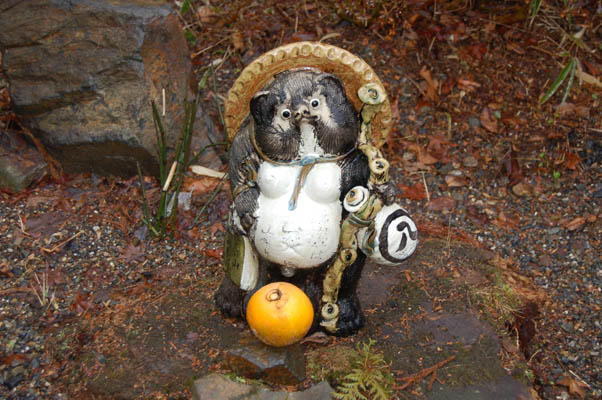
Ponpoko pon no pon is the onomotopoetic Japanese expression of how tanuki move. When I saw one running, I was impressed by the accuracy of which ponpoko pon no pon captures their wobbly gait.
Known erroneously as a "badger" or "raccoon" and more accurately as a "raccoon-dog", Tanuki is the only word that fits this animal. The same goes for words like sushi, ramen (translated as Chinese noodle soup), tsukemono (Japanese pickles), miso (fermented soy bean paste), or samurai. The English translation takes something away from the native word by giving an unsatisfactory description.
Apparently, some people eat tanuki in the more rural areas. One of my brother?s friends from Tenri Daigaku described the meat as being gamy and tough. She said that a friend of her family came by the house and dropped off a parcel of meat, which they prepared in a miso-based broth. Miso, it was explained, is a good complementary base to use with gamy meat.
One of my friend?s grandfathers, who lives in Kita-Kyushu, is an avid huntsman. He regularly shoots tanuki but only keeps the fur. His daugher, my friend?s mother, makes the pelts into hats and other rustic clothing, which I like to think he wears on his hunting trips.
Recently I watched an excellent animation produced by Miyazaki Hayao called 平成狸合戦ぽんぽこ(Heisei Tanuki Gassen Ponpoko). At first glance I didn?t expect this anime to be anything that I would be interested in, but it actually deals with such serious issues as social, economic, and environmental problems, the chief one being urban sprawl in the Kanto region of Japan. I highly recommend this film to anyone who is interested in Japanese culture, folklore, or history, as it is bursting full of references to almost everything you can think of.
One thing that still alludes me about the tanuki is why udon with age on top is called tanuki udon, while putting this on top of soba makes it kitsune udon. Does anyone know anything about the history or lore dealing about these two popular meals?

Comments (6)
That's one of the few Hayao movies I haven't seen actually, Adam. I'll be looking for it in the local bideo sutoaa! Thanks for the tip.
Posted by: ronan | March 20, 2006 5:32 PM
Posted on: March 20, 2006 17:32
Yeah, check it out. I think you'd like it...
Posted by: Adam | March 20, 2006 11:58 PM
Posted on: March 20, 2006 23:58
udon is thicker, while soba is thinner. tanuki is fatter, while kitsune is skinnier. I'd bet both animals are omnivores, eating basically the same thing. And they most certainly live in the same areas. So there you go. The animal is the 'men', what they eat is the 'age', and where they live is the soup. Presto.
Posted by: Architeuthis | March 21, 2006 9:04 AM
Posted on: March 21, 2006 09:04
A concise and eloquent explanation. I like it...
Posted by: Adam | March 21, 2006 10:12 AM
Posted on: March 21, 2006 10:12
Soooo.....Arkeetoothus is like the fatter , er, Reubenesque Tanuki and so that's his fave....while Adam is fashionably skinny and therefore likes Kitsune udon? I get it!
Posted by: YoMama | March 23, 2006 12:26 PM
Posted on: March 23, 2006 12:26
Dude, if you run across an old-fashioned ceramic Tanuki or find one that someone doesn't want anymore, maybe you can bring it back.....Jichan gave dad his favorite Tanuki and it stood in our entryway for a couple of years....it was about 18 inches high and quite old. It was perhaps one of the only real antiques that dad liked....but unfortunately, one that your bratty cousins broke while goofing around. Kids!
Anyways, don't spend a lot of dough on it, as it's just another "thing"....and dad would probably love to travel and see the "Adam's Insider" places with you instead!
Posted by: YoMama | March 23, 2006 12:37 PM
Posted on: March 23, 2006 12:37